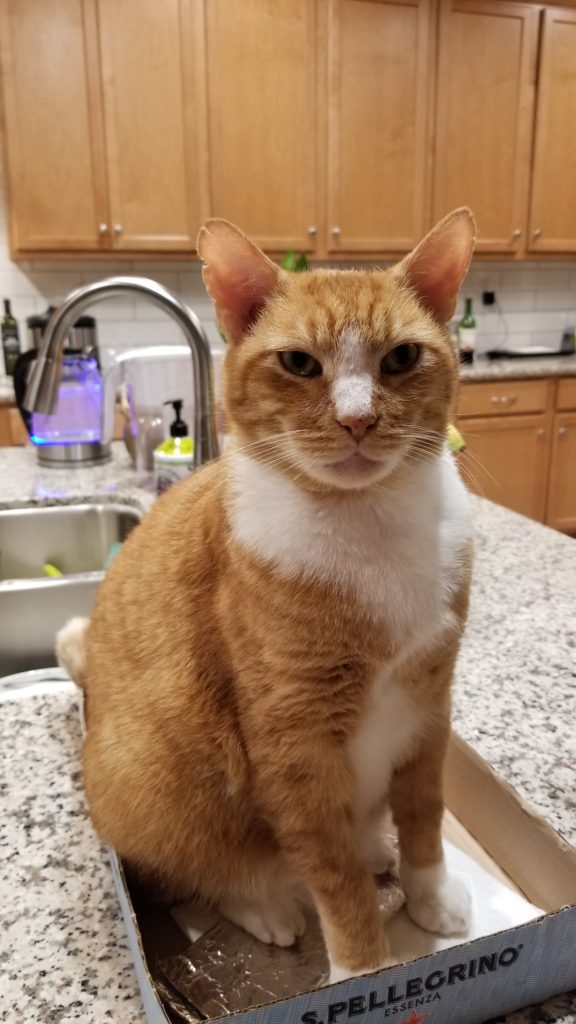
Before our second cat, Marley, came to our family, he was deemed unadoptable and scheduled for euthanasia at an animal shelter. What was happening was Marley nipped people’s hands and legs when they petted him. The biting wasn’t hard, and Marley never broke the skin; however, the nipping was irritating. Because of the unfortunate nipping habit, the poor cat was at high risk of losing his life. You can find Marley’s complete story here: Marley’s story.
Fortunately, SNAP cats rescue stepped in timely and rescued our adventurous boy. We fell in love with Marley, and he’s been living with us happily since he moved in. Today, we will talk about our experiences managing Marley’s nipping behavior. We will share some tips on dealing with a “temperamental” cat in the household.
Consult with a health professional.
The first thing is to consult your veterinarian and rule out a medical issue. Remember that your cat may be experiencing an illness and not trying to make you upset. As always, the cat’s doctor is the first place to call. The vet will examine your furry friend, perform the necessary diagnostic and tell you the nature of the problem.
Observe your cat’s behavior.
When you have a cat with problematic behavior, you need to find out an underlying reason for such behavior. In most cases, the cats have some motivation or a reason to act the way they do. The cats are no different from other creatures when it comes to behavior.
Observe your cats as much as you can. Look at the patterns in their behaviors. When do they start acting up, and what triggers them? Is there anything that aggravates the situation or makes it better? A few years ago, we experienced an unusual episode with our cat Sunny.
Look for the causing factors.
One day, Sunny pulled his ears towards the back of his head; his eyes were big and round. Sunny hackled his back and puffed up his tail. Our cat produced no sound but presented frozen and terrified. We couldn’t understand what happened and called the emergency veterinary hospital. When we brought Sunny to the clinic, he stepped out of his carrier and appeared less tense. He walked on the counter and didn’t show any signs of fear or anger that he experienced at home earlier. The doctor checked our cat and didn’t find anything wrong with him. The vet referred us to an animal behavior specialist at UC Davis School of Veterinary Medicine.
Get rid of the triggers.
When we returned home, Sunny continued his strange behavior. His body was tense, with the hackled back and puffed tail. The ears pointed toward the back. We started checking our room to see what could be threatening for Sunny. We found that Sunny was uncomfortable around our 8-year-old daughter. We trusted our daughter and knew that she didn’t hurt Sunny and didn’t do anything that could be dangerous to the cat. The only different thing was Sasha was wearing a headband with wolf ears, a souvenir from my university.
We asked Sasha to remove the headband with the ears, and Sunny returned to his usual self right away. We received our Sunny back and had never had problems like that again!
Praise desired behaviors.
We learned the priceless lesson from the episode with Sunny and became more conscious about our environment around the cats. When Marley came to our family, we knew about his issue with nipping and decided to modify the behavior and work on his socialization.
We observed Marley and how he reacted to touch and pets. Marley loves attention and thrives on love. He enjoys being petted, mostly around his head and neck. However, if you pet him for too long or touch his rear body, Marley starts nipping and hissing.
We worked with Marley by petting his head and neck for a short time every time he requested attention. If Marley managed without nipping, we gave him tasty food or treats. Soon Marley was able to go for greater periods without biting.
Avoid reinforcing unwanted behaviors.
We noticed that Marley bites a hand every time we stop petting him. He asks us to continue petting him by nipping our skin. In a situation like that, avoid accidental reinforcement of the biting behavior. When a cat nips you, immediately stop petting him and stay calm.
We agreed that every time Marley bites, we will ignore him and withhold touches or words. On the contrary, when Marley acts nicely, doesn’t bite, and is a gentleman, we carefully shower him with touching, scratching, love and treats.
Avoid yelling and screaming at your cat. Never hit a cat or any animal. Cats don’t understand why you are upset. When you yell at them, cats don’t understand a reason and get scared of you. Instead, re-direct your four-legged friend and move on with another activity. Keep your cat from doing something you don’t want him to do by distracting his attention.
Provide activities incompatible with unwanted behavior.
Another element we noticed was that Marley prefers to nip only certain spots, soft body tissues, such as the forearm, nose, cheek, or back of the upper arm. He doesn’t bite a palm or fingers. Next, we provided only “non-chewable” parts of our bodies when we petted Marley, our fingers, and our palms for him to lick. Additionally, Marley enjoys laying on our chests. When he comes, we position him far enough from our faces, so he can’t bite the noses and cheeks. We talk gently and pet Marley in short strikes, touching his head and not exposing our “soft” parts to Marley’s teeth.
With our interventions, the instances of nipping decreased, and Marley could manage longer times without biting. Today, Marley enjoys attention and is not much different from any other cat.
In this article, we discussed our personal experiences with minor behavioral issues in our cats. If your cat experiences a situation of severe aggression, consult your veterinarian immediately. We will address the aggression topic in another posting.

2 thoughts on “How to Manage a Temperamental Cat”
bookmarked!!, I really like your website!
Here is my blog post – family
Hello, thank you for your comment. I apologize for the delay with the response. Still learning the functionality of the website. Thank you!